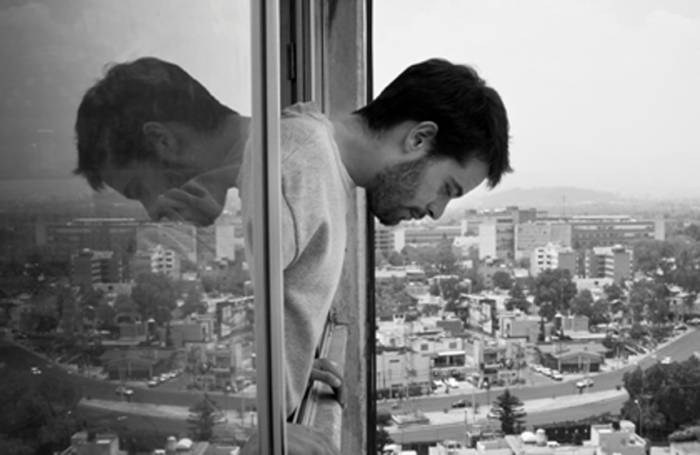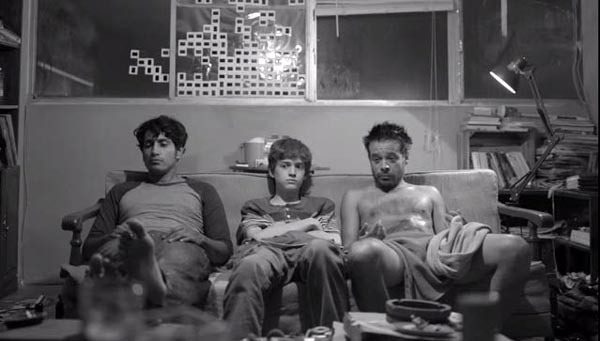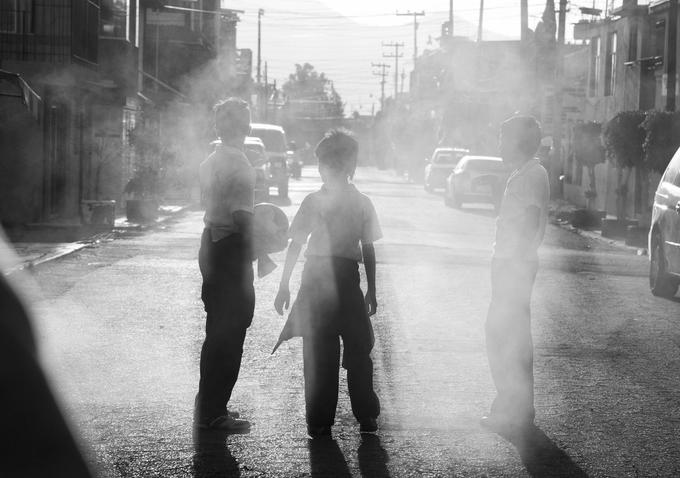
After settling in Paris in 1902, Ranier Maria Rilke became Auguste Rodin’s secretary. Aware the writer had been in a creative drought, the sculptor recommended he visit the Jardin des Plantes and watch an animal. Rilke chose to document the movements of a panther, and his visits culminated in perhaps his most famous poem, a piece he titled in honor of the mammal he had intimately studied. “The Panther” resulted in a refined aesthetic for Rilke. His observations became his art: he developed what he labeled as his “thing poems,” abandoning his subjective verses in favor of objective ones that represented his personal ideas, thoughts, and emotions. Here, in the first stanza, the panther paces:
His vision, from the constantly passing bars,
has grown so weary that it cannot hold
anything else. It seems to him there are
a thousand bars; and behind the bars, no world.
Committed to memory, these are the lines uttered by Federico “Sombra” Ruiz (Tenoch Huerta), the student-poet of Antonio Ruizpalacios’s debut feature, Güeros. It’s 1999 in Mexico City, and as a result of the ongoing protests at his college, the National Autonomous University of Mexico (UNAM), Sombra has been out of school. Uncertain of his future, he finds himself plagued by constant panic attacks, bouts of anxiety he describes as the hauntings of a “tiger.” As he quotes Rilke to Ana (Ilse Salas), a girl whom he loves but has never quite dated, he watches the creature of his nightmares walk back and forth in captivity at the zoo. It’s a literal confrontation of his metaphorical fear, a visual take on Rilke’s words: to view Güeros is to see a “thing poem” on the screen, to witness something like “The Panther” materialize. Seen through physical objects (a cassette player, a rundown car, a neglected computer), the mystical Mexico City, with its winding roads, its curbside gardens, its cyclical aimlessness, becomes a symbol for Güeros’s struggling and disaffected youths, an external rendering of what’s most internal.
 Admittedly, I’m a sucker for this sort of mythology, the potential influence an artistic discipline has on another: the notion that Henry James stopped by John Singer Sargent’s Parisian flat to see Madame X in-process holds many implications for me, namely that the novelist not only admired the portraits of his American companion abroad but that he could have seen the painter toiling with his masterpiece. Shot in black-and-white, in the “Academy ratio” of Golden Age Hollywood, Güeros has already elicited several comparisons within its medium’s tradition: its shifting static-to-shaky camerawork and Godardian existentialism are credited to the French New Wave; its Mexico City shares similarities with Jim Jarmusch’s New York of the 1980s; and its characters bear resemblance to those in other Mexican art house films, notably the lost souls in Alfonso Cuarón’s Y Tu Mamá También and Duck Season. However, not enough critical attention and credit has been given to the film’s literary elements, figures, and allusions, especially considering so much of it centers on our words—on what “lies behind” our passions and our obsessions, our resistance and our ambivalence, our actions and our language.
Admittedly, I’m a sucker for this sort of mythology, the potential influence an artistic discipline has on another: the notion that Henry James stopped by John Singer Sargent’s Parisian flat to see Madame X in-process holds many implications for me, namely that the novelist not only admired the portraits of his American companion abroad but that he could have seen the painter toiling with his masterpiece. Shot in black-and-white, in the “Academy ratio” of Golden Age Hollywood, Güeros has already elicited several comparisons within its medium’s tradition: its shifting static-to-shaky camerawork and Godardian existentialism are credited to the French New Wave; its Mexico City shares similarities with Jim Jarmusch’s New York of the 1980s; and its characters bear resemblance to those in other Mexican art house films, notably the lost souls in Alfonso Cuarón’s Y Tu Mamá También and Duck Season. However, not enough critical attention and credit has been given to the film’s literary elements, figures, and allusions, especially considering so much of it centers on our words—on what “lies behind” our passions and our obsessions, our resistance and our ambivalence, our actions and our language.
The term “güero” is now so embedded in the cultural fabric of Mexico that Ruizpalacios didn’t realize until the final cut before the premiere date, at the Berlin Film Festival last year, that foreign audiences might not recognize it. In an interview with Filmmaker Magazine, he reveals how his production team “quickly looked the word up in several dictionaries and added the definition at the very beginning.” Light-skinned or light-haired, “güero” derives from huero, an empty egg lost during the incubation period, but it’s “thrown around” so much in Mexico, Ruizpalacios remarks, that “nobody ever stops to wonder what they really mean, what [they’re] really saying”: “they are strong words charged with the desire to place a barrier between you and… whomever the other might be.” Ruizpalacios introduces this dichotomy with Tomás (Sebastián Aguirre), Sombra’s troublesome younger brother, who arrives in the capital after dropping a water balloon from the roof of a building and onto a stranger’s baby: their worn-out mother in Veracruz “can’t handle” him anymore and sends him away. Together in Mexico City, the brothers have no trouble becoming the topic of conversation. Each person who meets Tomás instantly remarks that he isn’t dark like Sombra. Tomás knows Sombra as “Fede”: he hasn’t heard the new nickname (the English equivalence of “shadow”), and his brother doesn’t allow him say it, just as he doesn’t permit him to use “esquirol” (a strikebreaker).
Instead, Sombra boldly declares that he and his roommate, Santos (Leonardo Ortizgris), are on “strike from the strike.” Really, though, they look and act more like James Franco and Seth Rogen in Pineapple Express than a duo of off-duty revolutionaries. They’ve gone from scholars to restless slackers. They both have theses to complete, but with the college closed, neither of them does any coursework: Sombra fails to master a simple card trick; Santos reads the newspaper. They have nothing to eat, they never wash their dishes, and they convince Aurora (Camila Lora), the girl who lives below them, to plug in an extension cord and power their appliances. At eight o’clock, they retire to bed, when the parents of their downstairs neighbor come home and rid them of their stolen electricity.
and power their appliances. At eight o’clock, they retire to bed, when the parents of their downstairs neighbor come home and rid them of their stolen electricity.
Presumably, Sombra isn’t the type of male influence Tomás’s mother intended for her son, continuing to mourn the passing of his dad. The sole thing that brings Sombra any joy, it seems, is the voice of the girl he loves. During the day, he, Santos, and Tomás lounge on the hood of the car and listen to Ana, the host of a pirate radio show for the movement, as she discusses politics: the protestors are debating between a silent march and the takeover of the television stations, and as she argues in favor of the former, she also reads a pair of poems—one written by her, the other, entitled “The Crane,” by Sombra. Ana was the person, we later learn, who exposed Rilke to Sombra, but his poetic roots may rest further back in time: though Sombra and Tomás’s father is a vague and mysterious figure, he introduced his sons to Epigmenio Cruz, a folk singer who, had he been more widely known, could have allegedly changed Mexican rock and roll. According to Tomás, he “once made Bob Dylan cry.” However, we never familiarize ourselves with Cruz’s songs, as Sombra, Santos, and Ana only hear them on Tomás’s headphones: whenever they put them over their ears, utter silence permeates. Cruz produced a single album, Los Güeros, and following its release, he seemingly vanished, transforming into more of a legend than an actual human being.
The fact that Cruz calls his record Los Güeros is the type of overt symbolism that almost requires no explanation, yet the analysis it invites proves too telling: since we don’t know the content of the work, we don’t know the identity of his “güeros.” As viewers, we’re in the position of so many Mexicans who are—and were—deprived of his songs. Still, the journey to find the man successfully propels the latter half of the film, and it’s Tomás’s hope to find the elusive musician that finally brings Sombra and Santos out of their ratty kitchen and onto the streets: it evolves into a mission for all of them, including Ana, who soon joins them. They set-off on a road trip that goes essentially nowhere, a darkly comic adventure that gets interrupted with misguided turns, dead ends, chases, a brief kidnapping, a faulty engine, a celebration, and eventually the protest itself. When something bad happens, it’s usually because Santos or Sombra, the alternating drivers, take a right instead of going straight, or go straight instead of taking a right. When they end-up somewhere crucial (the university, or Cruz’s favorite bars), it’s always by accident. Much like Roberto Bolaño’s wandering critics in search of their hero, Benno von Archimboldi, in 2666, or his visceral realists looking for the “mother” of their artistic movement, Cesárea Tinajero, in The Savage Detectives, Ruizpalacios’s characters aren’t so much looking for a source of meaning than they are running away from what plagues them: Tomás is unable to behave in Veracruz; Sombra and Santos can’t decide if they should grab picket signs, or wait for the unrest to dissipate; and Ana battles, as a woman and a vocal advocate for peace, to solidify her place as a leader. Not even the director himself seems able to commit to his purpose, and in the two distinct cases when Güeros breaks the fourth wall—once to debate the quality of the screenplay, then again to mock the current state of Mexican cinema and the stereotypes it produces—Ruizpalacios makes his most pervasive theme explicit: history won’t wait for any of them, and it doesn’t have to remember them, either.
 At a certain point, traveling down the highway, Ana asks the men if anybody will notice if they die. When Tomás, Sombra, and Santos don’t have much of response, she turns-off the ignition and lets the vehicle rest in the middle lane, a stark, stationary contrast to the throngs of people marching for the future of free higher education. It’s an absurd, hyperbolically symbolic act that again triggers Bolaño, particularly the moment when Amulet’s Auxilio Lacouture, the “mother of Mexican poetry,” hides in a bathroom stall for thirteen days, the single person to resist the army’s violent invasion of UNAM in 1968. Although it never overtakes, the Tlatelolco massacre weighs in the background of the current events, a past that foreshadows the present. In other words, the cultural relevance of Tomás, Sombra, Santos, and Ana stays undecided, and it’s a question Ruizpalacios never forgets, as he often disarmingly shifts to the point-of-view of a new, peripheral character without warning. When a group of upper-class men, en route to a party celebration for a Mexican director, accost a convenience store employee about buying cigarettes after closing, it’s not until their harassment reaches a peak (they’re on the verge of pushing their way through the door) that Santos presents himself in the frame and intervenes. In Güeros’s opening scene, Ruizpalacios follows the frantic casualty of Tomás’s harmless prank, as she tries to get out the door with her crying baby; in a parallel sequence toward the end, he cuts to a young boy, similarly without context: we watch as the child flees from two bullies, grabs a brick, and climbing to the top of a bridge, dangles it over the highway. The difference between this kid and Tomás might be the difference between a brick and water balloon, but it’s also a clear indication that the perspective of Güeros’s mainly four-person cast doesn’t remain stable: they are at times the victims, and they are at times the heroes.
At a certain point, traveling down the highway, Ana asks the men if anybody will notice if they die. When Tomás, Sombra, and Santos don’t have much of response, she turns-off the ignition and lets the vehicle rest in the middle lane, a stark, stationary contrast to the throngs of people marching for the future of free higher education. It’s an absurd, hyperbolically symbolic act that again triggers Bolaño, particularly the moment when Amulet’s Auxilio Lacouture, the “mother of Mexican poetry,” hides in a bathroom stall for thirteen days, the single person to resist the army’s violent invasion of UNAM in 1968. Although it never overtakes, the Tlatelolco massacre weighs in the background of the current events, a past that foreshadows the present. In other words, the cultural relevance of Tomás, Sombra, Santos, and Ana stays undecided, and it’s a question Ruizpalacios never forgets, as he often disarmingly shifts to the point-of-view of a new, peripheral character without warning. When a group of upper-class men, en route to a party celebration for a Mexican director, accost a convenience store employee about buying cigarettes after closing, it’s not until their harassment reaches a peak (they’re on the verge of pushing their way through the door) that Santos presents himself in the frame and intervenes. In Güeros’s opening scene, Ruizpalacios follows the frantic casualty of Tomás’s harmless prank, as she tries to get out the door with her crying baby; in a parallel sequence toward the end, he cuts to a young boy, similarly without context: we watch as the child flees from two bullies, grabs a brick, and climbing to the top of a bridge, dangles it over the highway. The difference between this kid and Tomás might be the difference between a brick and water balloon, but it’s also a clear indication that the perspective of Güeros’s mainly four-person cast doesn’t remain stable: they are at times the victims, and they are at times the heroes.
It’s a reminder that none of them are representative of Mexico City, but rather Mexico City—the falling bricks, the ideological slogans, the rhythms of poets, and the anger of a generation—is representative of them.
***
Image credits: featured image, image #2, image#3, image #4.




